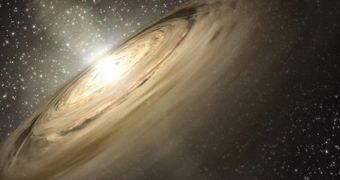An analysis of the Sun's protoplanetary disk, to be published in an upcoming issue of the esteemed Astronomical Journal, reveals that the structure was not different from similar formations occurring around other stars. The main issue – size – was proven to have been standard.
Every star has a protoplanetary disk around it once it collapses from its precursor hydrogen cloud. The disk is made up of materials that did not fall into the star when the latter ignited. Cosmic dust and gas make up the bulk of matter in the disks.
Over time, small grains begin to form inside the disk as it spins around the star. These clumps steadily grow, until they eventually become comets, asteroids, protoplanets, dwarf planets, rocky worlds, gas giants, moons and every other structure that can be found in a star system, Science Now reports.
The new study reveals that the Sun's protoplanetary disk was only 80 astronomical units wide, which is standard for a yellow dwarf star. That value is equivalent to 80 times the mean distance between the Earth and the Sun, or about 7,440,000,000 miles (11,973,000,000 kilometers).

 14 DAY TRIAL //
14 DAY TRIAL //